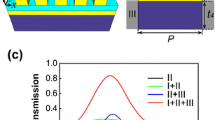Abstract
Whereas resonant transverse magnetic transmission across an undulated continuous metal film is achieved with the mediation of plasmon modes excited by the undulation, it is shown here that transverse electric (TE) resonant transmission through a continuous metal film can also be achieved with the mediation of the second-order TE1 mode of a dielectric slab waveguide having the metal film sandwiched at its middle. The demonstration is made by using the materials currently used in the domain of optical security and counterfeit deterrence: ZnS is shown to possibly be a lossless interface/adhesion layer between a polymer and a noble metal for plasmonic resonant elements.






Similar content being viewed by others
References
Mashev L, Popov E (1985) Zero order anomaly of dielectric coated gratings. Opt Commun 55:377–380
Golubenko GA, Svakhin AS, Sychugov VA, Tishchenko AV (1985) Total reflection of light from a corrugated surface of a dielectric waveguide. Sov J Quant Electron 15:886–887
Avrutsky IA, Sychugov VA (1989) Reflection of a beam of finite size from a corrugated waveguide. J Mod Opt 36:1527–1539
Jourlin Y, Tonchev S, Tishchenko AV, Pedri C, Veillas C, Parriaux O, Last A, Lacroute Y (2009) Spatially and polarization resolved plasmon mediated transmission through continuous metal films. Opt Express 17:12155–12166
Parriaux O, Tonchev S, Jourlin Y (2012) Recovery of lost photons in plasmon-mediated transmission through undulated metal film. ECIO’012, Barcelona, 18–20 April 2012
Nikolajsen T, Leosson K, Salakhutdinov IF, Bozhevolnyi SI (2003) Polymer-based surface-plasmon-polariton stripe waveguides at telecommunication wavelengths. Appl Phys Lett 82:668–670
Ritter E, Hoffmann R (1969) Influence of substrate temperature on the condensation of vacuum evaporated films of MgF2 and ZnS. J Vac Sci Technol 6:733–736
Wu X, Lai F, Lin L, Lv J, Zhuang B, Yan Q, Huang Z (2008) Optical inhomogeneity of ZnS films deposited by thermal evaporation. Appl Surf Sci 254:6455–6460
Leftheriotis G, Yianoulis P, Patrikios D (1997) Deposition and optical properties of optimised ZnS/Ag/ZnS thin films for energy saving applications. Thin Solid Films 306:92–99
Liu X, Cai X, Qiao JH, Mao L, Jiang N (2003) The design of ZnS/Ag/ZnS transparent conductive multilayer films. Thin Solid Films 441:200–206
Acknowledgments
The authors of the French laboratories are very grateful to their colleagues of the ISSP Institute of Solid State Physics of the Bulgarian Academy of Sciences for their expertise in layer deposition and for supplying a number of characterized and optimized resonant structures.
Author information
Authors and Affiliations
Corresponding author
Rights and permissions
About this article
Cite this article
Tonchev, S., Parriaux, O., Tenev, T. et al. Resonant TE Transmission Through a Continuous Metal Film: Perspectives for Low-Loss Plasmonic Elements. Plasmonics 8, 829–833 (2013). https://doi.org/10.1007/s11468-013-9479-0
Received:
Accepted:
Published:
Issue Date:
DOI: https://doi.org/10.1007/s11468-013-9479-0




